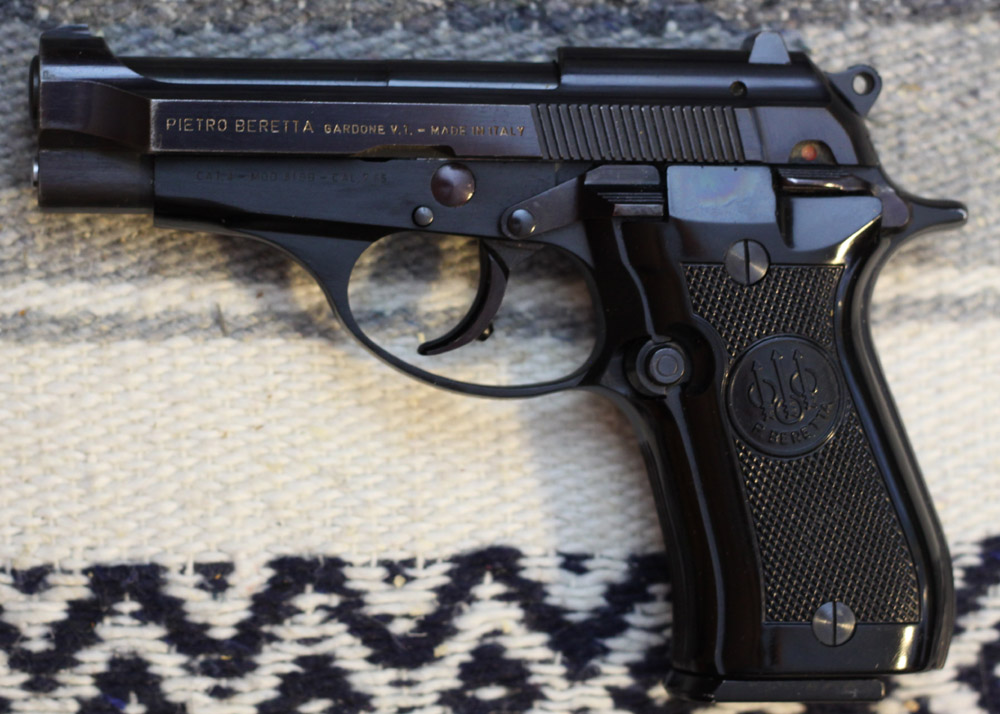
Beretta M81 "Cheetah"
| Dimensions | Barrel Length | Weight | Caliber | Action Type | Magazine Capacity |
| 6.8" x 3.75" x 0.87" |
3.82" |
24 oz |
.32 ACP (7.65x17) |
DA Semi |
12 (nominal) |
The Gun James Bond
should have carried
 Back in 1976, around the time the Beretta M92 was adopted as
the US M9 issue arm, Beretta designed a series of handguns
it called the Cheetah line. The Cheetah was a series of
medium sized semi-auto handguns in less than full powered
service cartridges which did not require a locked breech
action. The guns were designed for police and civilian use.
Back in 1976, around the time the Beretta M92 was adopted as
the US M9 issue arm, Beretta designed a series of handguns
it called the Cheetah line. The Cheetah was a series of
medium sized semi-auto handguns in less than full powered
service cartridges which did not require a locked breech
action. The guns were designed for police and civilian use.
The model 84 was in 380, and boasted a 13 round magazine. The model 81 was in .32, and featured a 12 round magazine. The model 87 is in 22 L.R. and has a single stack 8 round magazine. Models 85, and 82 were later introduced with single stack magazines in 380 and 32. There were some other variants, including a target model in 22; but these were the main versions.This series is still in production, though they vary in some details from these earlier versions. .
These guns are often used in movies and television, due to their flowing lines and European feel. Italian designers, whether of yachts, shoes, handbags, or automobiles, have a knack for timeless elegant products. The M81, in common with all of the Cheetah models, has a curved and streamlined appearance, unlike the blocky handguns in common production today. The gun settles comfortably into the hand, and Beretta seems to have learned the secret that the human body is composed of curves
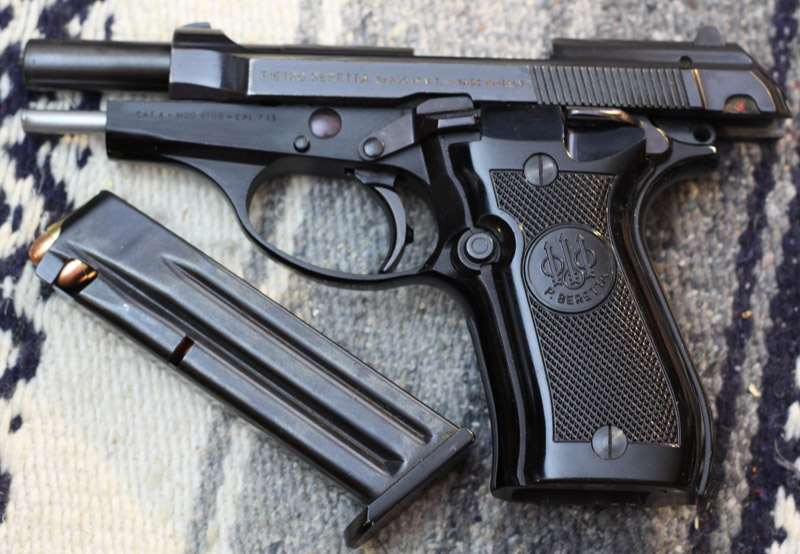 , rather than straight lines, and that
curves equal comfort in a handgun.
, rather than straight lines, and that
curves equal comfort in a handgun. At the time of its development, the model 81 was a cutting edge handgun. It had everything a handgun was thought to need. The model featured a double column magazine of 12 rounds. It had a double action trigger, and an aluminum frame. The BB version had the then popular three dot sights, and an ambidextrous safety. The magazine release is just behind the trigger and, though not ambidextrous, can be set up for either left or right hand operation. This was, and probably still is, the best 32 handgun you can buy. I believe it far outclasses even the venerable Walther PPK.
The model 81 is a medium sized handgun,ideal for casual carry, though not quite small enough for deep concealment. It features a straight blow back action, with no locking mechanism. The all metal gun features an aluminum frame and a steel slide and barrel. The grips are generally of black checkered plastic embossed with the Beretta logo, though wood grips are available. The front and rear of the grip portion of the frame are ridged on the BB model, or plain on the standard model.
The lanyard style hammer is serrated for cocking, for those who do not wish a double action first shot. The frame mounted safety blocks the slide, and is in safe mode when up, and ready to fire when down, which is the preferred style of American shooters, as introduced by the classic 1911. Many European handguns reverse this. There is no hammer drop, so it is possible to carry in traditional cocked and locked mode, also preferred by American shooters. In this mode, the hammer is cocked with the safety engaged. One welcome deletion is the absence of a magazine safety. I never cared for this feature, and it could be a serious handicap in a situation where a magazine is damaged.
The action is the now classic double action/single action combination. The amazingly good double action trigger has almost no creep, and no overtravel. It is smooth and breaks cleanly. There is a small button on the back edge of the trigger that is likely responsible for the lack of overtravel. Double action trigger pull was at around six pounds on my example. The single action pull has a bit of creep, but breaks very crisply, and has a pull of about 3.5 pounds. The trigger itself is wide and serrated.

The open top slide is iconic of all Beretta models, a legacy of the German P-38 influence, and enhances ejection by leaving the chamber completely open during recoil. In the larger calibers, it is made possible by the P-38 style locking mechanism that such models use, which locks the action on the chamber area rather than on the barrel. On the Cheetah series, these lighter calibers do not require a locking action, but the styling is carried over from their big brothers. It is possible that the more open action might allow easier penetration by dirt and the weather; but service in the military of several nations, and countless police agencies has proven the viability of the design.
 A
look at the top of the gun shows a great family resemblance
to the M92, and gives a good idea of the sight picture. The
chamber is distinct from the barrel, and is clearly stamped
with the European caliber markings. Unlike the barrels of
most semi automatic handguns, the Beretta barrel is not
hidden within a slide, and so requires a suitable finish
that matches the rest of the gun. In this case, it is a
beautiful traditional gunmetal blue, though nickel, and a
teflon-like coating called Bruniton are also available.
A
look at the top of the gun shows a great family resemblance
to the M92, and gives a good idea of the sight picture. The
chamber is distinct from the barrel, and is clearly stamped
with the European caliber markings. Unlike the barrels of
most semi automatic handguns, the Beretta barrel is not
hidden within a slide, and so requires a suitable finish
that matches the rest of the gun. In this case, it is a
beautiful traditional gunmetal blue, though nickel, and a
teflon-like coating called Bruniton are also available.The barrel is mounted rigidly in the frame, and does not move during firing. The full length slide could probably be shortened to just the portion behind the chamber, but the slight added weight and inertia likely help with reliability, and give the front sight a place to rest, other than the barrel. The oversized front of the slide leaves plenty of tolerance for the barrel.
 The Model 81 is chambered in .32 A.C.P. which is the first
cartridge designed by firearms legend John M. Browning. He
designed it in 1896 for his 1900 model semi automatic
pistol. This was produced in Europe by FN, and was the
beginning of a century long European love affair with the
.32 caliber. The most popular European chambering of the
classic Walther PPK, and the equally iconic Mauser HSc was
.32. This was the caliber carried by James Bond in the
books.
The Model 81 is chambered in .32 A.C.P. which is the first
cartridge designed by firearms legend John M. Browning. He
designed it in 1896 for his 1900 model semi automatic
pistol. This was produced in Europe by FN, and was the
beginning of a century long European love affair with the
.32 caliber. The most popular European chambering of the
classic Walther PPK, and the equally iconic Mauser HSc was
.32. This was the caliber carried by James Bond in the
books. The .32 A.C.P. cartridge gets little respect in America, and is not very popular here. America is the land of the magnum, of the big .45, and the classic .38. We are just beginning to see the merit of the little .380 auto, as it is being applied to a new generation of ultra small carry guns. Perhaps a new found popularity for the .32 will follow. This is my first and so far only 32. In truth, the little 32 does have some things in its favor.
The .32 A.C.P. has exceptionally little felt recoil, particularly in a gun the size and weight of the M81. This is very close to rim-fire levels of recoil. This makes the gun easy to fire, and allows for rapid follow up shots. It also makes for pleasant practice.
Ballistically, the 32 generates around 128 fp, by pushing a 71 grain bullet at around 900 fps. Like most modern production cartridges, this can vary a bit, with some manufacturers using heavier or lighter bullets, a variety of powders, and bullet styles. The jury is out on this cartridge. Many point to the long standing popularity of this round with European police forces, while others compare it unfavorably with the 22.. The most direct competitor of this cartridge is the little 380 round,
 often chambered in the same pistols as the
32. The 380 is considered the minimum round suitable for
self defense, by some, and generates 190 fp of energy by
pushing a 95 grain bullet at the same 900 fps as the 32.
These figures are all subject to change, as cartridge
developers ply their trade. Some amazing things have been
done with the 380, since its rise to popularity in a new
generation of very small handguns. It remains to be seen,
what may be done with the diminutive 32. Everything is a
matter of balance. The limited power of this cartridge is
balanced by its ease of shooting. As far as effectiveness is
concerned, if the shooter does his part, the cartridge will
suffice.
often chambered in the same pistols as the
32. The 380 is considered the minimum round suitable for
self defense, by some, and generates 190 fp of energy by
pushing a 95 grain bullet at the same 900 fps as the 32.
These figures are all subject to change, as cartridge
developers ply their trade. Some amazing things have been
done with the 380, since its rise to popularity in a new
generation of very small handguns. It remains to be seen,
what may be done with the diminutive 32. Everything is a
matter of balance. The limited power of this cartridge is
balanced by its ease of shooting. As far as effectiveness is
concerned, if the shooter does his part, the cartridge will
suffice. I picked up my own example of the M81, retail at a local gun shop. As of this writing (October 2019), these little jewels are available at bargain prices. A large batch of surplus M81 pistols have flooded the American market. These are former Italian police pistols, which have been sold off in bulk. The importer is PW arms. These guns are probably worth double the $230 or so being asked. No doubt the prices will slowly rise, once these guns sell out. New examples sell for around $600 My particular example, as can be seen in the photos, is beautiful almost perfect. There is no holster wear, no sign of any rust anywhere, not even surface rust, and I see no scuff marks. I will never know the complete history of this gun, but it appears to never have been carried.
 Magazines are impossible to find right now, and cost around
$50 each when available. With the pistol itself selling for
a mere $230, I would almost buy another pistol, rather than
spring for $50 for a new magazine. Eventually the costs of
the magazines will drop, even as the cost of the pistol
rises. Holsters are a bit easier to procure, as the 380
model 84 Cheetah is quite a popular gun. My own example
presently rests in an Uncle Mike's Sidekick holster, in size
16. It is a perfect fit. A gun like this probably deserves a
fitted leather holster, but the Nylon of the Sidekick lessen
fears of rust on the slide.
Magazines are impossible to find right now, and cost around
$50 each when available. With the pistol itself selling for
a mere $230, I would almost buy another pistol, rather than
spring for $50 for a new magazine. Eventually the costs of
the magazines will drop, even as the cost of the pistol
rises. Holsters are a bit easier to procure, as the 380
model 84 Cheetah is quite a popular gun. My own example
presently rests in an Uncle Mike's Sidekick holster, in size
16. It is a perfect fit. A gun like this probably deserves a
fitted leather holster, but the Nylon of the Sidekick lessen
fears of rust on the slide. Concerns about the lethality of the little 32 aside, this gun is a real pleasure to shoot. The double column magazine makes for a rather wide pistol, comfortable to hold, with a large energy absorbing grip. The grip portion of the frame is well grooved, both front and back, and the plastic grips are smoothly contoured and well checkered. The weight too, helps with recoil management. Best of all is the very manageable recoil generated by the little 32 cartridge. Firing this pistol is not too different than shooting a sporting 22.
Also adding to the ease of shooting, is the truly excellent trigger. This trigger is wide, grooved, and is very much like that found on a target pistol. The clean break in both double and single action, and the complete lack of overtravel help with
 accuracy. This gun will mostly be fired
single action, at a nice crisp 3.5 pounds, with only a tiny
bit of creep, allow for a considerable amount of precision.
accuracy. This gun will mostly be fired
single action, at a nice crisp 3.5 pounds, with only a tiny
bit of creep, allow for a considerable amount of precision.
The simple blade front sight is nothing special, though it does have a white recessed dot, to be used with a matching dot on the rear sight. The rear sight is quite nice, for a gun of this size, and has a recessed square aperture. With these sights, trigger, and handling qualities, I am able to put all of the little 32 rounds into one or two ragged holes.
Experiences with the pistol make me rethink some traditional attitudes about the little 32, and about what makes a good defensive handgun. This is the traditional police and civilian cartridge in Europe, much as the old 38 Special is the traditional police and civilian handgun cartridge in America. The 32 served well enough in this role for a hundred years, and serves still. It brings to mind the idea of balance.
As originally designed by John M Browning, the 32 ACP was ideally balanced for the medium frame automatic. The cartridge shoots comfortably, accurately, and dependably in such a gun. I happen to own a Walther PPK, similar in size to this gun. The PPK was originally chambered in 32, and worked well as a police and military handgun in this caliber. To make the gun more palatable for American shooters, the gun was also chambered in 380. I own such a gun, in 380, and can personally attest to the fact that it is quite unpleasant to shoot.
As a carry gun, the M81 is almost ideally sized, and the weight is not intrusive. Most holsters designed for mid sized semi autos will fit. Eventually magazines will be available; but for now I have to get by on the one included with the gun.
The real allure of this gun is that it is fantastically well made, feels good on the hip, looks great, and is very easy to shoot. It is nothing like today's polymer wonders, the classic old 1911, or the venerable revolver. The lines flow and curve like a martial sculpture. The lines of the gun are quite complex, and I imagine the machining takes skill and time.
 To
make things even better, these guns are now available at a
very affordable Price. I have had my eye on one since the
late seventies; but could never justify paying as much for a
little 32, as I might pay for a full sized 1911, or a good
magnum revolver. I did buy the old Browning BDA in 380,
which is essentially the same gun in 380 caliber. It would
have been nice to have this as a companion gun in a smaller
caliber; but these were not easy to find, and were expensive
when located.
To
make things even better, these guns are now available at a
very affordable Price. I have had my eye on one since the
late seventies; but could never justify paying as much for a
little 32, as I might pay for a full sized 1911, or a good
magnum revolver. I did buy the old Browning BDA in 380,
which is essentially the same gun in 380 caliber. It would
have been nice to have this as a companion gun in a smaller
caliber; but these were not easy to find, and were expensive
when located. There are a lot of people who will not buy this gun, due to the caliber; but for me it is just the opposite. I have not previously owned any firearm in 32 caliber, and was anxious to get one to round out my collection of handguns. As mentioned above, it may be that for a gun this size, 32 is a near ideal caliber in terms of handling. Not every gun should be a hand canon. One big downside of this caliber is expense. Ironically, due to the lack of popularity of this round here in the United States, the little 32 rounds can cost as much as double the cost of 9mm ammunition. I can only hope that with an increase in popularity, that this will change.
I love surplus firearms. They are generally well taken care of, tend to be of top quality, and have a history of use as work guns. These great little surplus guns are presently being imported by PW Arms out of Redmond Washington, as is proudly and prominently displayed in their import markings on the bottom of the trigger guard. I can not find any information on how many of them were brought over, or how many are left. I am considering buying another, more on speculation than for a shooter. These guns will increase in value once the current surplus supply runs out.
In the meantime, these are fun to shoot, if reasonably priced ammunition can be found, look good, are unique, and are viable, if minimal, self defense and carry guns. At their present cost, they are an absolute bargain. They are also quite easy to disassemble and clean, as shown in the photo sequence included below.

| Disassembly for
cleaning |
|
 |
The M81, like all modern Beretta
pistols, is easy to field strip. The first step is
to remove the magazine. It is then very important,
after the magazine has been ejected, to rack the
slide so that the chamber is guaranteed empty. |
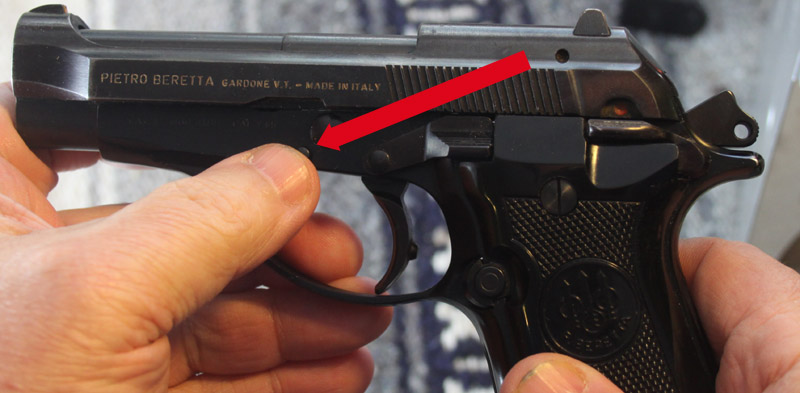 |
On the left hand side of the frame is
a take down pin. This must be pushed in from the
left in order to free up the take down lever. |
 |
Push the take down lever forward and
down, until it locks and you see the slide move
forward slightly. |
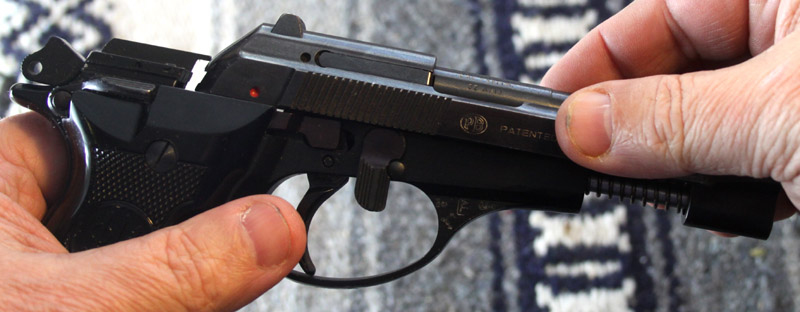 |
You may then pull the slide
completely off of the frame. |
 |
Push the recoil spring assembly
slightly forward, and then lift it from the barrel
and remove from the slide. |
 |
The barrel may then be pushed
slightly forward, and pulled up out of the slide. |
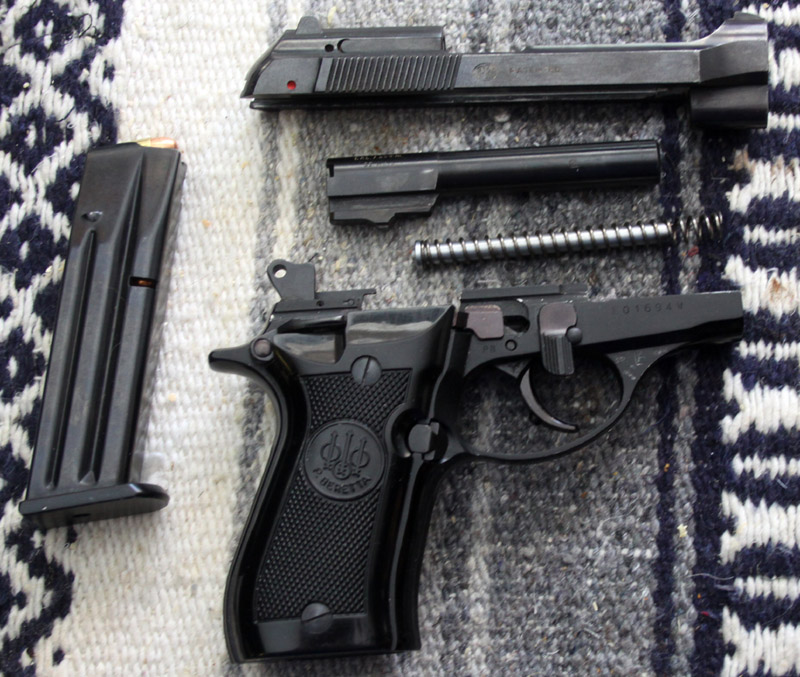 |
The Beretta M81 is now properly field
stripped for cleaning and lubrication.
properly field stripped. |
